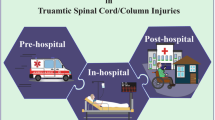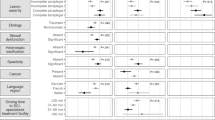Abstract
Study design
Descriptive study of the results of a web-based consultation service for individuals with spinal cord injury (SCI).
Objectives
To review frequently asked questions (FAQ) among individuals with SCI and determine the most important topics.
Setting
Sina Trauma and Surgery Research Center, Tehran University of Medical Sciences, Tehran, Iran.
Methods
A cross-sectional study reviewing questions from patients with SCI that were collected from the Health and Safety Consultant Center (HSCC) between January and December 2015. The HSCC is a web-based medical consultation service that provides patients with information and counseling pertaining to SCI.
Results
A total of 113 questions were collected from 99 individuals. The mean age was 32.02 ± 13.28 years with a range of 3–70 years. Men accounted for 81.7% of the questions, while women accounted for 18.3%. The most common site of SCI was thoracic (40.6%), followed by lumbar (31.3%), and cervical (28.1%). Recovery potential (38.1%), sexual and reproductive issues (26.5%), urinary (10.6%), and motor (10.6%) problems were among the most commonly reviewed topics.
Conclusions
FAQ provide insight on areas of concerns for individuals with SCI and help guide providers to determine high-yield topics. Discerning the specific areas of need or concern for patients is instrumental in developing pertinent educational materials and programs, in addition to efficiently counseling patients and caregivers on the aftercare of SCI.
Similar content being viewed by others
Log in or create a free account to read this content
Gain free access to this article, as well as selected content from this journal and more on nature.com
or
References
Rahimi-Movaghar V, Sayyah MK, Akbari H, et al. Epidemiology of traumatic spinal cord injury in developing countries: a systematic review. Neuroepidemiology. 2013;41:65–85.
Panagioti M, Richardson G, Murray E, et al. Reducing care utilisation through self-management interventions (RECURSIVE): a systematic review and meta-analysis. Southampton, UK: NIHR Journals Library; 2014.
Chaitchik S, Kreitler S, Shaked S, Schwartz I, Rosin R. Doctor-patient communication in a cancer ward. J Cancer Educ. 1992;7:41–54.
Norman C, Bender JL, Macdonald J, et al. Questions that individuals with spinal cord injury have regarding their chronic pain: a qualitative study. Disabil Rehabil. 2010;32:114–24.
Whitehurst DG, Noonan VK, Dvorak MF, Bryan S. A review of preference-based health-related quality of life questionnaires in spinal cord injury research. Spinal Cord. 2012;50:646–54.
Tuffrey C, Finlay F. Use of the internet by parents of paediatric outpatients. Arch Dis Child. 2002;87:534–6.
Whitford DL, Paul G, Smith SM. Patient generated “frequently asked questions”: Identifying informational needs in a RCT of peer support in type 2 diabetes. Prim Care Diabetes. 2013;7:103–9.
Goodman N, Jette AM, Houlihan B, Williams S. Computer and internet use by persons after traumatic spinal cord injury. Arch Phys Med Rehabil. 2008;89:1492–8.
Kruisinga FH, Heinen RC, Heymans HS. Analysis of the question-answer service of the Emma Children’s Hospital information centre. Eur J Pediatr. 2010;169:853–60.
Bolman C, Brug J, Bar F, Martinali J, van den Borne B. Long-term efficacy of a checklist to improve patient education in cardiology. Patient Educ Couns. 2005;56:240–8.
Grant RW, Altschuler A, Uratsu CS, et al. Primary care visit preparation and communication for patients with poorly controlled diabetes: a qualitative study of patients and physicians. Prim Care Diabetes. 2017;11:148–53.
Drainoni M-L, Houlihan B, Williams S, et al. Patterns of Internet use by persons with spinal cord injuries and relationship to health-related quality of life. Arch Phys Med Rehabil. 2004;85:1872–9.
Carlson BA, Neal D, Magwood G, Jenkins C, King MG, Hossler CL. A community-based participatory health information needs assessment to help eliminate diabetes information disparities. Health Promot Pract. 2006;7(3_suppl):213S–22S.
Hill MR, Noonan VK, Sakakibara BM, Miller WC, Team SR. Quality of life instruments and definitions in individuals with spinal cord injury: a systematic review. Spinal Cord. 2010;48:438.
Munce SE, Perrier L, Tricco AC, et al. Impact of quality improvement strategies on the quality of life and well-being of individuals with spinal cord injury: a systematic review protocol. Syst Rev. 2013;2:14.
Acknowledgements
This research has been supported by Tehran University of Medical Sciences and Health Services.
Author information
Authors and Affiliations
Corresponding author
Ethics declarations
Conflict of interest
ARV is a board member of AOSpine, Innovative Surgical Design, Association of Collaborative Spine Research, DePuy; Consultant at Medtronics, Stryker Spine, Globus, Stout Medical, Gerson Lehrman Group, Guidepoint Global, Medacorp, Innovative Surgical Design, Orthobullets, Ellipse, Vertex, Medtronics; Royalty at Stryker Spine, Biomet Spine, Globus, Aesculap, Thieme, Jaypee, Elsevier, Taylor Francis. All the remaining authors declare that they have no conflict of interest.
Rights and permissions
About this article
Cite this article
Rezaei, M., Omidbeigi, M., Hanaei, S. et al. Frequently asked questions of individuals with spinal cord injuries: results of a web-based consultation service in Iran. Spinal Cord Ser Cases 4, 50 (2018). https://doi.org/10.1038/s41394-018-0085-4
Received:
Revised:
Accepted:
Published:
DOI: https://doi.org/10.1038/s41394-018-0085-4
This article is cited by
-
A Scoping Review of Literature on Sexual Health and Wellness in Women with Spinal Cord Injury
Sexuality and Disability (2024)
-
Evaluation of sexual reproductive health needs of women with spinal cord injury in Tehran, Iran
Sexuality and Disability (2022)



